Themed collection Open access articles from Soft Matter

Durable and scalable icephobic surfaces: similarities and distinctions from superhydrophobic surfaces
Formation, adhesion, and accumulation of ice, snow, frost, glaze, rime, or their mixtures can cause severe problems for solar panels, wind turbines, aircrafts, heat pumps, power lines, telecommunication equipment, and submarines.
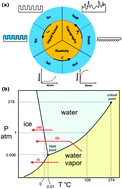
Soft Matter, 2016,12, 1938-1963
https://doi.org/10.1039/C5SM02295A
One-step production of multiple emulsions: microfluidic, polymer-stabilized and particle-stabilized approaches
We review recently developed methods to make stable multiple emulsions via a single mixing step. These successes may make it easier to exploit multiple emulsions in food science and elsewhere.

Soft Matter, 2016,12, 998-1008
https://doi.org/10.1039/C5SM01663K
Using Brownian motion to measure shape asymmetry in mesoscopic matter using optical tweezers
We quantify the asymmetry of single optically trapped red blood cells from the cross-correlation between their rotational and translational Brownian motion.
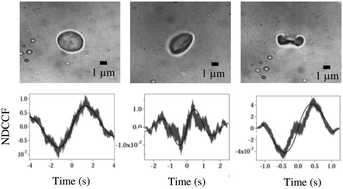
Soft Matter, 2016,12, 5077-5080
https://doi.org/10.1039/C6SM00264A
Sub-nanometre mapping of the aquaporin–water interface using multifrequency atomic force microscopy
Multifrequency atomic force microscopy is used to gain sub-nanometre insights into the structure of aquaporin 0 and its interface with the surrounding water.
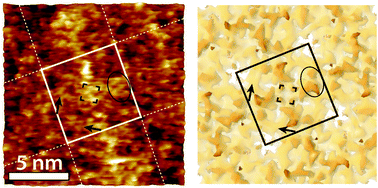
Soft Matter, 2017,13, 187-195
https://doi.org/10.1039/C6SM00751A
Understanding the twist-bend nematic phase: the characterisation of 1-(4-cyanobiphenyl-4′-yloxy)-6-(4-cyanobiphenyl-4′-yl)hexane (CB6OCB) and comparison with CB7CB
The design and characterisation of the nonsymmetric liquid crystal dimer, 1-(4-cyanobiphenyl-4′-yloxy)-6-(4-cyanobiphenyl-4′-yl) hexane (CB6OCB) is reported.
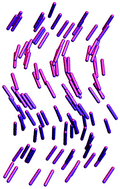
Soft Matter, 2016,12, 6827-6840
https://doi.org/10.1039/C6SM00537C
Nonlinear elasticity of semiflexible filament networks
We develop a continuum theory for equilibrium elasticity of a network of crosslinked semiflexible filaments, spanning the full range between flexible entropy-driven chains to stiff athermal rods. Negative normal stress and network stability boundary follow from the compact analytical expressions of the theory.
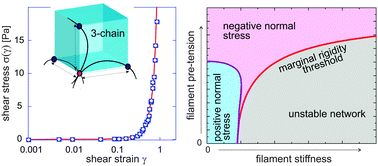
Soft Matter, 2016,12, 6749-6756
https://doi.org/10.1039/C6SM01029F
Swelling of phospholipid membranes by divalent metal ions depends on the location of the ions in the bilayers
While ions, which bind close to the glycerol group of DMPC membranes, cause minor increase in bilayer hydration, ions which bind to the phosphate were found to cause significant increases in hydration.
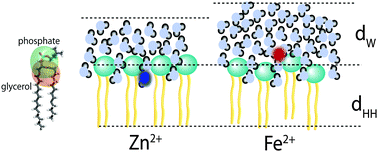
Soft Matter, 2016,12, 6737-6748
https://doi.org/10.1039/C6SM00695G
Hydrodynamic coupling of particle inclusions embedded in curved lipid bilayer membranes
We investigate the drift-diffusion dynamics of particle inclusions embedded within the leaflets of curved lipid bilayer membranes. We consider the roles played by coupling through (i) intramembrane hydrodynamics, (ii) traction stresses with the external solvent fluid, and (iii) intermonolayer slip between the leaflets. Theoretical results and general simulation methods are presented for investigations of the collective drift-diffusion of interacting inclusion particles within curved lipid bilayers.
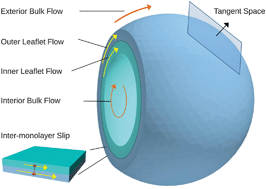
Soft Matter, 2016,12, 6685-6707
https://doi.org/10.1039/C6SM00194G
Controlled capillary assembly of magnetic Janus particles at fluid–fluid interfaces
We show that capillary interactions induced by magnetic Janus particles can assemble monolayers of Janus particles into highly-ordered structures. Further, using theoretical models and computer simulations of two particles we show that the interactions between the particles are tunable. Our results have implications for the fabrication of re-configurable colloidal materials.

Soft Matter, 2016,12, 6566-6574
https://doi.org/10.1039/C6SM01201A
Structure and dynamics of concentration fluctuations in a non-equilibrium dense colloidal suspension
We study concentration fluctuations during diffusion of a dense colloidal suspension into water. We find two diffusion coefficients that depend on time and tend asymptotically to the same value for long times, when the concentration gradient vanishes.

Soft Matter, 2016,12, 6588-6600
https://doi.org/10.1039/C6SM00935B
Changes in the bending modulus of AOT based microemulsions induced by the incorporation of polymers in the water core
The bending modulus κ is known to be a crucial parameter for the stability of the droplet phase. By combination of droplet radii and percolation temperature Tp it is found to increase under the addition of polymer, if the correct droplet radii at Tp are considered.

Soft Matter, 2016,12, 6400-6411
https://doi.org/10.1039/C6SM01253A
The interaction of protein-coated bionanoparticles and surface receptors reevaluated: how important is the number of bonds?
Specifically designed bionanoparticles with a function-oriented protein-coating layer interact with self-prepared receptor surfaces as the counterpart.
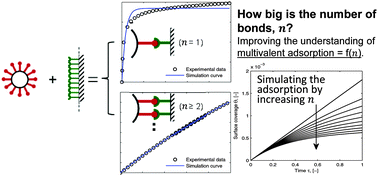
Soft Matter, 2016,12, 6451-6462
https://doi.org/10.1039/C6SM00995F
Steady-state droplet size in montmorillonite stabilised emulsions
The formation of hexadecane-in-water emulsions stabilised by montmorillonite platelets was studied. Particle desorption needs to be taken into account to predict the steady-state droplet size distribution.
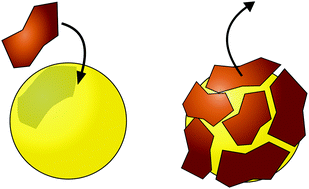
Soft Matter, 2016,12, 6481-6489
https://doi.org/10.1039/C6SM01377E
Wrinkles on a textile-embedded elastomer surface with highly variable friction
For reversible wrinkling to induce substantial tunability of friction force, this study proposes a new structural design with a biaxial textile sheet embedded on an elastomer surface.

Soft Matter, 2016,12, 6176-6183
https://doi.org/10.1039/C6SM00728G
DNA brick self-assembly with an off-lattice potential
We show that many-component addressable self-assembly of DNA bricks is possible to achieve with a coarse-grained but realistic off-lattice model.
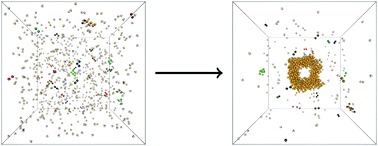
Soft Matter, 2016,12, 6253-6260
https://doi.org/10.1039/C6SM01031H
The stabilizing effect of shear thinning on the onset of purely elastic instabilities in serpentine microflows
We determine both experimentally and numerically the onset of elastic flow instabilities in viscoelastic polymer solutions with different levels of shear thinning.
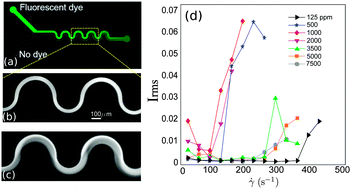
Soft Matter, 2016,12, 6167-6175
https://doi.org/10.1039/C6SM00326E
Specific effects of Ca2+ ions and molecular structure of β-lactoglobulin interfacial layers that drive macroscopic foam stability
β-Lactoglobulin adsorption layers at air–water interfaces were studied with sum-frequency generation, tensiometry, surface dilatational rheology and ellipsometry.

Soft Matter, 2016,12, 5995-6004
https://doi.org/10.1039/C6SM00636A
Glass transitions in native silk fibres studied by dynamic mechanical thermal analysis
Silks are a family of semi-crystalline structural materials, spun naturally by insects, spiders and even crustaceans.
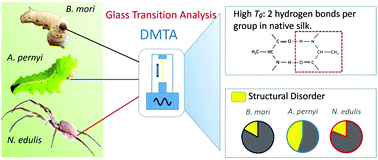
Soft Matter, 2016,12, 5926-5936
https://doi.org/10.1039/C6SM00019C
Diffusive properties of solvent molecules in the neighborhood of a polymer chain as seen by Monte-Carlo simulations
The influence of both polymer chain length and concentration on the mobility of solvent molecules in polymer solutions was studied by Monte Carlo simulations with the use of the dynamic lattice liquid (DLL) model.
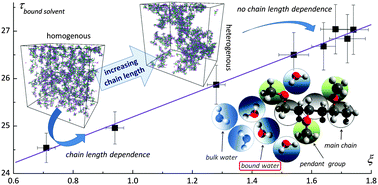
Soft Matter, 2016,12, 5519-5528
https://doi.org/10.1039/C6SM00569A
Kinetics of formation of bile salt micelles from coarse-grained Langevin dynamics simulations
Bile monomers can leave bile micelles rapidly, which may enable solubilization mechanisms not possible with head–tail surfactants.
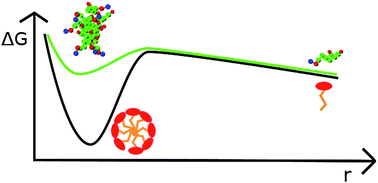
Soft Matter, 2016,12, 5172-5179
https://doi.org/10.1039/C6SM00763E
Coupled instabilities of surface crease and bulk bending during fast free swelling of hydrogels
This work investigates the mechanical coupling of surface instability and bulk bending.
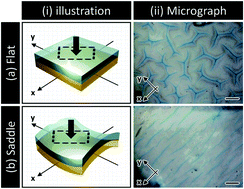
Soft Matter, 2016,12, 5081-5088
https://doi.org/10.1039/C6SM00578K
Double-network hydrogels improve pH-switchable adhesion
For environmentally-switchable adhesive systems to be reused repeatedly, the adhesive strength must not deteriorate after each adhesion cycle.

Soft Matter, 2016,12, 5022-5028
https://doi.org/10.1039/C6SM00656F
Rupture and recoil of bent-core liquid crystal filaments
The recoil process of viscoelastic free-standing liquid crystal filaments is investigated experimentally and theoretically.
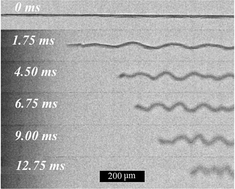
Soft Matter, 2016,12, 4725-4730
https://doi.org/10.1039/C6SM00290K
Porosity of silica Stöber particles determined by spin-echo small angle neutron scattering
Open and closed volume fractions determined for Stöber silica in deuterated and hydrogenous solvents.
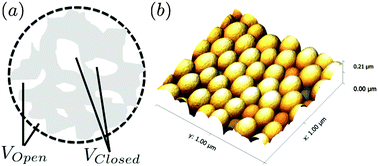
Soft Matter, 2016,12, 4709-4714
https://doi.org/10.1039/C5SM02772A
Rheology of cubic particles suspended in a Newtonian fluid
Many real-world industrial processes involve non-spherical particles suspended in a fluid medium.
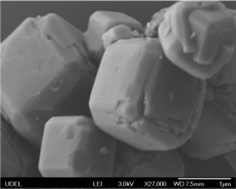
Soft Matter, 2016,12, 4654-4665
https://doi.org/10.1039/C6SM00205F
From soft to hard rod behavior in liquid crystalline suspensions of sterically stabilized colloidal filamentous particles
Hard rod behavior is found in dense suspensions of PEGylated filamentous viruses allowing for direct, i.e. without any free parameter, quantitative comparison with theory and computer simulations.

Soft Matter, 2016,12, 4621-4627
https://doi.org/10.1039/C6SM00527F
Dynamically controlled deposition of colloidal nanoparticle suspension in evaporating drops using laser radiation
Particle deposition in a homogeneous or arbitrary distribution can be obtained by direct exposure to an infrared laser beam.
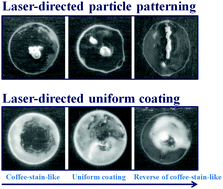
Soft Matter, 2016,12, 4530-4536
https://doi.org/10.1039/C6SM00465B
State behaviour and dynamics of self-propelled Brownian squares: a simulation study
We study the state behaviour of self-propelled and Brownian squares as a function of the magnitude of self-propulsion and density using Brownian dynamics simulations.
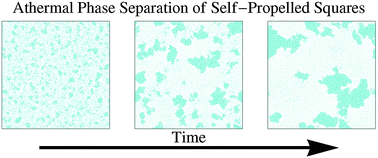
Soft Matter, 2016,12, 4309-4317
https://doi.org/10.1039/C6SM00347H
Gravitational collapse of depletion-induced colloidal gels
We study the ageing and ultimate gravitational collapse of colloidal gels in which the interparticle attraction is induced by non-adsorbing polymers via the depletion effect.
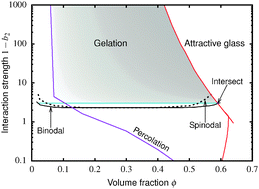
Soft Matter, 2016,12, 4300-4308
https://doi.org/10.1039/C5SM02651B
In situ modification of nanostructure configuration through the manipulation of hydrogen bonded amphiphile self-association
Previously overlooked simple amphiphiles show an exciting capacity for complex hydrogen bond mediated self-association and diverse nanostructure formation.
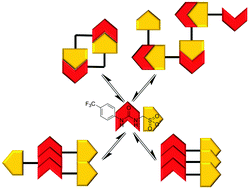
Soft Matter, 2016,12, 4221-4228
https://doi.org/10.1039/C6SM00529B
A study of conductive hydrogel composites of pH-responsive microgels and carbon nanotubes
pH-Responsive microgels can disperse carbon nanotubes and act as macro-crosslinkers to give hydrogel composites with ductilities that increase with increasing modulus.

Soft Matter, 2016,12, 4142-4153
https://doi.org/10.1039/C6SM00223D
The evolution of bicontinuous polymeric nanospheres in aqueous solution
Complex polymeric nanospheres in aqueous solution are desirable for their promising potential in encapsulation and templating applications.
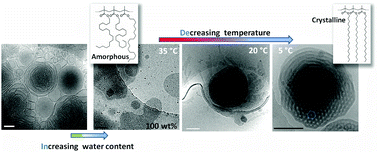
Soft Matter, 2016,12, 4113-4122
https://doi.org/10.1039/C6SM00053C
The apparent charge of nanoparticles trapped at a water interface
Long-ranged dipolar interactions between charged particles trapped at a water interface are determined by the particles' apparent charge.
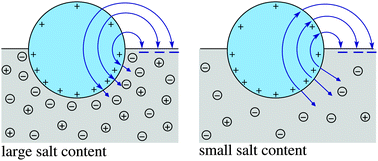
Soft Matter, 2016,12, 4229-4240
https://doi.org/10.1039/C6SM00334F
Quantitative morphological characterization of bicontinuous Pickering emulsions via interfacial curvatures
Bicontinuous Pickering emulsions (bijels) are a physically interesting class of soft materials with many potential applications including catalysis, microfluidics and tissue engineering.
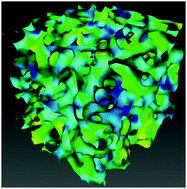
Soft Matter, 2016,12, 4082-4092
https://doi.org/10.1039/C5SM03102H
Substituent interference on supramolecular assembly in urea gelators: synthesis, structure prediction and NMR
–NO2 and –OCH3 substituents were shown to differ in their ability to interfere with the H-bond interactions between ureas during supramolecular gelation.
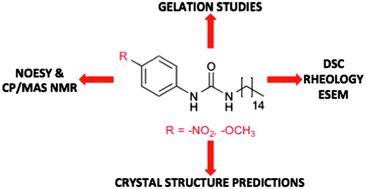
Soft Matter, 2016,12, 4034-4043
https://doi.org/10.1039/C6SM00607H
Upper bound on the Edwards entropy in frictional monodisperse hard-sphere packings
We extend the Widom particle insertion method [B. Widom, J. Chem. Phys., 1963, 39, 2808–2812] to determine an upper bound sub on the Edwards entropy in frictional hard-sphere packings.
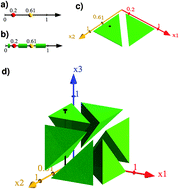
Soft Matter, 2016,12, 3991-4006
https://doi.org/10.1039/C6SM00567E
Linking micellar structures to hydrogelation for salt-triggered dipeptide gelators
The hierarchical structure of a dipeptide micellar phase is characterised and linked with the corresponding salt-triggered hydrogel phase.
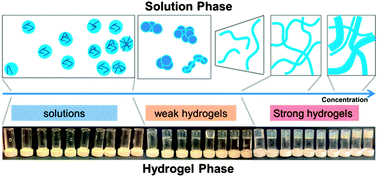
Soft Matter, 2016,12, 3612-3621
https://doi.org/10.1039/C5SM03072B
Revealing the signature of dipolar interactions in dynamic spectra of polydisperse magnetic nanoparticles
We investigate, via a modified mean field approach, the dynamic magnetic response of a polydisperse dipolar suspension to a weak, linearly polarised, AC field.
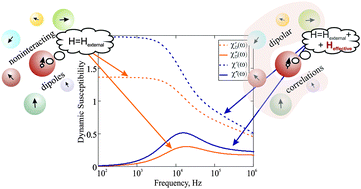
Soft Matter, 2016,12, 3507-3513
https://doi.org/10.1039/C5SM02679B
Mechanical spectroscopy of retina explants at the protein level employing nanostructured scaffolds
Nanostructured scaffolds are employed as vibrating reeds with retinal tissue cultured on top. From a change in vibration frequency, the mechanical properties of the retina at the nanoscale can be quantified using finite element calculations.
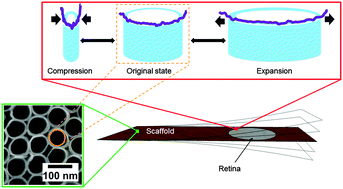
Soft Matter, 2016,12, 3431-3441
https://doi.org/10.1039/C6SM00293E
Multi-stage freezing of HEUR polymer networks with magnetite nanoparticles
We observe a change in the segmental dynamics of hydrogels based on hydrophobically modified ethoxylated urethanes (HEUR) when hydrophobic magnetite nanoparticles (MNPs) are embedded in the hydrogels.
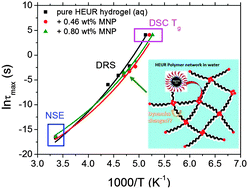
Soft Matter, 2016,12, 3214-3225
https://doi.org/10.1039/C6SM00074F
Lateral pressure-mediated protein partitioning into liquid-ordered/liquid-disordered domains
We have studied the contributions of stored elastic energies in liquid-ordered (Lo) and liquid-disordered (Ld) domains to transmembrane proteins using the lateral pressure concept.
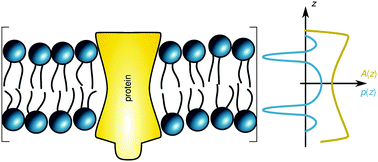
Soft Matter, 2016,12, 3189-3195
https://doi.org/10.1039/C6SM00042H
Amyloid-β25–35 peptides aggregate into cross-β sheets in unsaturated anionic lipid membranes at high peptide concentrations
A membrane mediated interaction leads to the formation of peptide clusters inside the bilayers, which may serve as nuclei for further growth into amyloid fibrils.
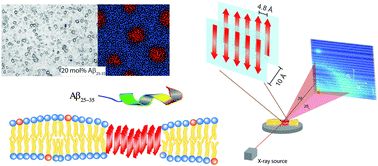
Soft Matter, 2016,12, 3165-3176
https://doi.org/10.1039/C5SM02619A
Local dynamic mechanical analysis for heterogeneous soft matter using ferrule-top indentation
We present a mm-sized, all-optical probe that can accurately quantify and map the viscoelastic properties of highly heterogeneous soft matter.
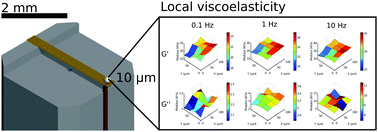
Soft Matter, 2016,12, 3066-3073
https://doi.org/10.1039/C6SM00300A
Supramolecular polymerisation in water; elucidating the role of hydrophobic and hydrogen-bond interactions
The self-assembly of a family of benzene-1,3,5-tricarboxamides (BTAs) in water is studied systematically to elucidate the role of hydrophobic and hydrogen-bond interactions.

Soft Matter, 2016,12, 2887-2893
https://doi.org/10.1039/C5SM02843D
Celebrating Soft Matter's 10th Anniversary: Simplicity in complexity – towards a soft matter physics of caramel
Master rheological spectra of our caramels over 12 orders of magnitude of frequency.
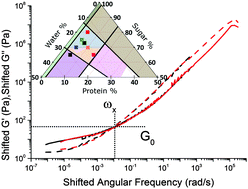
Soft Matter, 2016,12, 2757-2765
https://doi.org/10.1039/C5SM01797A
Effect of heterocyclic capping groups on the self-assembly of a dipeptide hydrogel
In this work it is shown that the selection of heterocyclic capping group for a dipeptide hydrogel affects the self-assembly pathway taken, resulting in differences in mechanical strength, network structure and thixotropic properties.

Soft Matter, 2016,12, 2700-2707
https://doi.org/10.1039/C6SM00025H
Bistable self-assembly in homogeneous colloidal systems for flexible modular architectures
Magnetic Janus particles with anisotropic magnetization distribution provide bistable self-assembly patterns, allowing for the growth of complex, flexible networks.

Soft Matter, 2016,12, 2737-2743
https://doi.org/10.1039/C5SM02899J
The pH-responsive behaviour of poly(acrylic acid) in aqueous solution is dependent on molar mass
Fluorescence spectroscopy on a series of aqueous solutions of poly(acrylic acid) containing a luminescent label showed that polymers with molar mass, Mn < 16.5 kDa did not exhibit a pH responsive conformational change, which is typical of higher molar mass poly(acrylic acid).
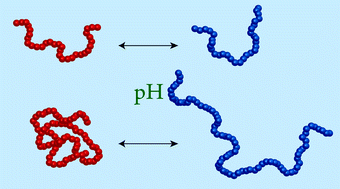
Soft Matter, 2016,12, 2542-2549
https://doi.org/10.1039/C5SM02693H
Buffering agents modify the hydration landscape at charged interfaces
We demonstrate, using atomic force microscopy and ellipsometry, that commonly-used buffers aggregate at the surface of mica and lipid bilayers, altering the structure of the interfacial water.
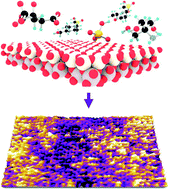
Soft Matter, 2016,12, 2642-2651
https://doi.org/10.1039/C5SM02445E
Elastic cavitation and fracture via injection
We model elasticity and fracture mechanisms giving rise to a critical pressure during soft material property characterization using cavitation rheology.
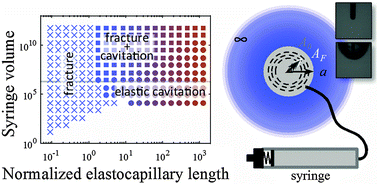
Soft Matter, 2016,12, 2557-2566
https://doi.org/10.1039/C5SM02055G
Molecular ordering in the high-temperature nematic phase of an all-aromatic liquid crystal
The high-temperature nematic phase of all-aromatic lath-like 2,6-biphenyl naphthalene (PPNPP) exhibits a surprisingly strong tendency towards molecular layering (i.e. SmA-like cybotaxis) and an orientational order parameter slightly deviating from Maier–Saupe theoretical prediction.
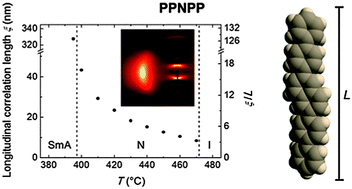
Soft Matter, 2016,12, 2309-2314
https://doi.org/10.1039/C5SM02738A
Open boundary molecular dynamics of sheared star-polymer melts
Shearing polymer melts at constant normal pressure produces different rheology than shearing at a constant volume, as revealed by AdResS-enabled open boundary MD simulations of star polymer melts.

Soft Matter, 2016,12, 2416-2439
https://doi.org/10.1039/C5SM02604K
Elastic deformations of bolalipid membranes
The newly developed elasticity theory for bolalipid membranes predicts an increased splay modulus that decelerates membrane fusion and fission.
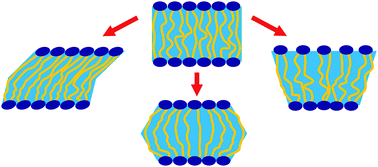
Soft Matter, 2016,12, 2357-2364
https://doi.org/10.1039/C5SM02635K
An optimized protocol for the analysis of time-resolved elastic scattering experiments
A deconvolution protocol is developed for obtaining material responses from time-resolved small-angle scattering data from light (SALS), X-rays (SAXS), or neutrons (SANS).
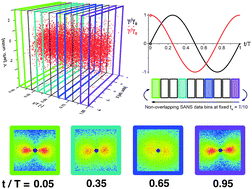
Soft Matter, 2016,12, 2301-2308
https://doi.org/10.1039/C5SM03039K
Crack patterns over uneven substrates
Cracks in thin layers are influenced by what lies beneath them.
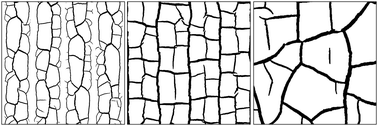
Soft Matter, 2016,12, 2253-2263
https://doi.org/10.1039/C5SM02389K
Influence of polymer shape on depletion potentials and crowding in colloid–polymer mixtures
Crowding by hard-sphere colloids affects shape distribution of a polymer coil, modeled as a fluctuating ellipsoid, modifying depletion-induced interactions.
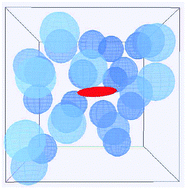
Soft Matter, 2016,12, 2247-2252
https://doi.org/10.1039/C5SM02863A
Self-assembly of three-dimensional ensembles of magnetic particles with laterally shifted dipoles
Using molecular dynamics simulations we investigate the self-assembly behaviour of colloidal particles with laterally shifted dipoles.
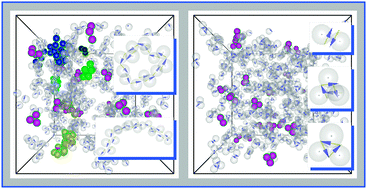
Soft Matter, 2016,12, 2066-2075
https://doi.org/10.1039/C5SM02648B
Weak reversible cross links may decrease the strength of aligned fiber bundles
The influence of weak reversible cross-linking on the mechanical properties of aligned, polymeric fiber bundles is investigated using computer simulations. It is shown that the presence of cross-links may effectively weaken the material. This effect strongly depends on the grafting density of the system.
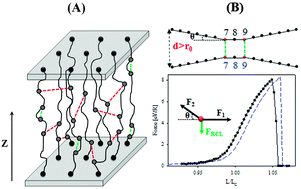
Soft Matter, 2016,12, 2047-2055
https://doi.org/10.1039/C5SM02614H
Dependence of norfloxacin diffusion across bilayers on lipid composition
Antibiotic resistance is a major concern in medicine, and a better understanding of the interactions of antibiotics with the lipid molecules found in bacterial membranes is therefore highly desirable. We study the permeation of the antibiotic norfloxacin across vesicle lipid membranes of variable lipid compositions, and show that norfloxacin permeation is dependent on both the type and relative concentration of lipid molecules in the membrane.
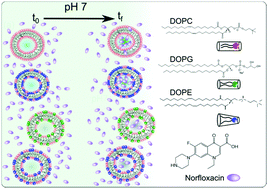
Soft Matter, 2016,12, 2135-2144
https://doi.org/10.1039/C5SM02371H
Supramolecular polyelectrolyte complex (SPEC): pH dependent phase transition and exploitation of its carrier properties
A supramolecular polyelectrolyte complex (SPEC) consisting of polyacrylic acid and guanidine is reported which can carry functional moieties like drugs and dyes and release them in certain pH conditions owing to pH dependent phase transitions of the complex.
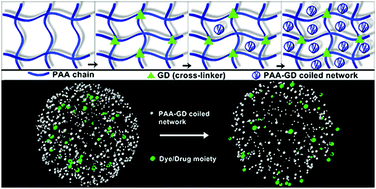
Soft Matter, 2016,12, 1989-1997
https://doi.org/10.1039/C5SM02732B
A modular self-assembly approach to functionalised β-sheet peptide hydrogel biomaterials
Designed complementary peptides self-assembled into β-sheet fibrils under physiological conditions to give cell-compatible hydrogels. N-terminal modification of one peptide component with RGD improved fibroblast viability and attachment.
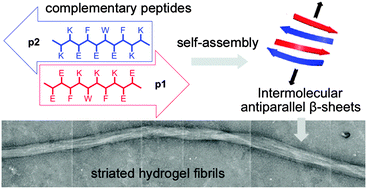
Soft Matter, 2016,12, 1915-1923
https://doi.org/10.1039/C5SM02039E
Imidazolium-based anion exchange membranes for alkaline anion fuel cells: elucidation of the morphology and the interplay between the morphology and properties
We investigated the morphology of a new graft-type anion exchange membrane by SANS technique.
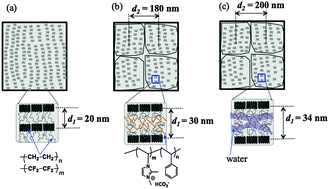
Soft Matter, 2016,12, 1567-1578
https://doi.org/10.1039/C5SM02724A
Cellulose regeneration and spinnability from ionic liquids
Ionic liquid solutions of cellulose can be spun into Lyocell-type textile fibers by dry-jet wet spinning.
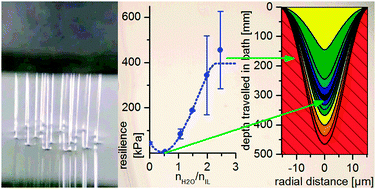
Soft Matter, 2016,12, 1487-1495
https://doi.org/10.1039/C5SM02618K
Composite hydrogels of polyacrylamide and crosslinked pH-responsive micrometer-sized hollow particles
Polyacrylamide composite hydrogels containing micrometer-sized pH-responsive hollow particles have tuneable mechanical properties that are governed by percolation.

Soft Matter, 2016,12, 1116-1126
https://doi.org/10.1039/C5SM02521D
Directional imbibition on a chemically patterned silicon micropillar array
Unidirectional, bidirectional and tridirectional imbibition of oils is demonstrated on silicon micropillar arrays with overlaid surface chemistry patterns.
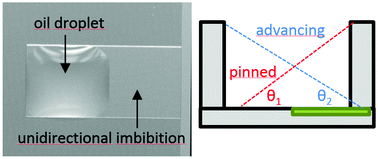
Soft Matter, 2016,12, 1100-1106
https://doi.org/10.1039/C5SM01746G
Relevance of saddle-splay elasticity in complex nematic geometries
Saddle-splay elastic interaction can notably affect the orientational ordering of nematic fluids in distinct regimes, including patterned geometries and complex-shaped colloids.
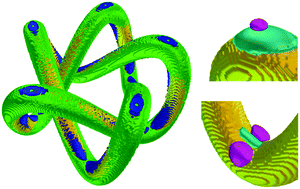
Soft Matter, 2016,12, 1313-1323
https://doi.org/10.1039/C5SM02417J
Formation of polyelectrolyte multilayers: ionic strengths and growth regimes
This article presents a study of layer-by-layer (LbL) formation of poly-electrolyte multilayers (PEMs).
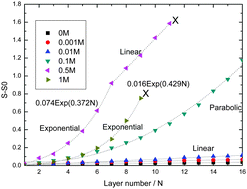
Soft Matter, 2016,12, 1032-1040
https://doi.org/10.1039/C5SM02118A
Compact micro/nano electrohydrodynamic patterning: using a thin conductive film and a patterned template
The influence of electrostatic heterogeneity on the electric-field-induced destabilization of thin ionic liquid (IL) films is investigated to control spatial ordering and to reduce the lateral dimension of structures forming on the films.
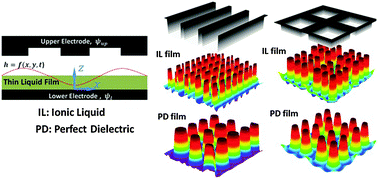
Soft Matter, 2016,12, 1074-1084
https://doi.org/10.1039/C5SM02258D
Oil-in-oil emulsions stabilised solely by solid particles
Relatively hydrophobic particles of different type, size and shape are shown to be effective stabilisers of emulsions containing immiscible oils of low dielectric constant. Transitional and catastrophic phase inversion can be effected and both simple and multiple emulsions are stable for a long period of time.
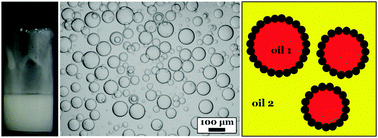
Soft Matter, 2016,12, 876-887
https://doi.org/10.1039/C5SM02438B
Shear thickening regimes of dense non-Brownian suspensions
A flow regime map for suspended particles that unifies aspects of colloidal, granular and soft-particle rheology across remarkably diverse scales.
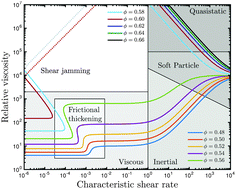
Soft Matter, 2016,12, 914-924
https://doi.org/10.1039/C5SM02326B
About this collection
This collection is made up of all Open Access articles published Soft Matter in 2016. Please follow the links for free access.